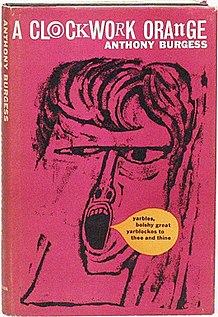
A Clockwork Orange is a dystopian satirical black comedy novel by English writer Anthony Burgess, published in 1962. It is set in a near-future English society that has a youth subculture of extreme violence. The teenage protagonist, Alex, narrates his violent exploits, and his experiences with state authorities intent on reforming him. The book is partially written in a Russian-influenced argot called "Nadsat", which takes its name from the Russian suffix that is equivalent to '-teen' in English. According to Burgess, it was a jeu d'esprit written in just three weeks.

Fahrenheit 451 is a dystopian novel by American writer Ray Bradbury, first published in 1953. It is regarded as one of his best works. The novel presents a future American society where books are outlawed and "firemen" burn any that are found. The book's tagline explains the title: "Fahrenheit 451 – the temperature at which book paper catches fire, and burns..." The lead character, Guy Montag, is a fireman who becomes disillusioned with his role of censoring literature and destroying knowledge, eventually quitting his job and committing himself to the preservation of literary and cultural writings.
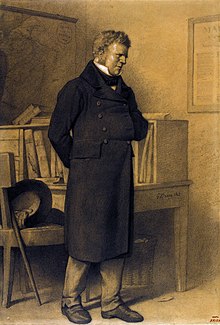
Les Misérables is a French historical novel by Victor Hugo, first published in 1862, that is considered one of the greatest novels of the 19th century. In the English-speaking world, the novel is usually referred to by its original French title. However, several alternatives have been used, including The Miserables, The Wretched, The Miserable Ones, The Poor Ones, The Wretched Poor, The Victims and The Dispossessed. Beginning in 1815 and culminating in the 1832 June Rebellion in Paris, the novel follows the lives and interactions of several characters, particularly the struggles of ex-convict Jean Valjean and his experience of redemption.

The Man with the Golden Gun is the twelfth novel of Ian Fleming's James Bond series. It was first published by Jonathan Cape in the UK on 1 April 1965, eight months after the author's death. The novel was not as detailed or polished as the others in the series, leading to poor but polite reviews. Despite that, the book was a best-seller.

The Secret Garden is a novel by Frances Hodgson Burnett first published in book form in 1911 following the publication in 1910 of a serial version in a US magazine. Set in England, it is one of Burnett's most popular novels and is considered a classic of English children's literature. Several stage and film adaptations have been made.

The Sword of Shannara is a 1977 epic fantasy novel by American writer Terry Brooks. It is the first book of the Original Shannara Trilogy, followed by The Elfstones of Shannara and The Wishsong of Shannara. Brooks was heavily influenced by J.R.R. Tolkien's The Lord of the Rings and began writing The Sword of Shannara in 1967. It took him seven years to complete, as he was writing the novel while attending law school. Ballantine Books used it to launch the company's new subsidiary Del Rey Books. Its success boosted the commercial expansion of the fantasy genre.
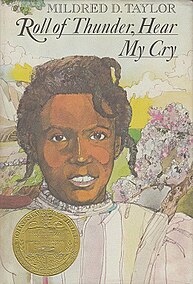
Roll of Thunder, Hear My Cry is a 1976 novel by Mildred D. Taylor, sequel to her 1975 novella Song of the Trees. It is a book about racism in America during the Great Depression. The novel won the 1977 Newbery Medal. It is followed by two more sequels, Let the Circle Be Unbroken (1981), The Road to Memphis (1990), and a prequel to the Logan family saga, The Land (2001).

Ministry of Fear is a 1944 film noir crime film directed by Fritz Lang. Based on a novel by Graham Greene, the film tells the story of a man just released from a mental asylum who finds himself caught up in an international spy ring and pursued by foreign agents after inadvertently receiving something they want. The original music for the film was composed by Miklós Rózsa and Victor Young.
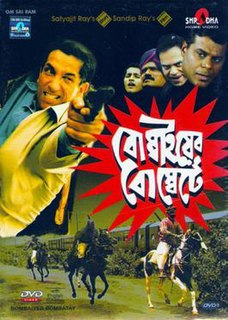
Bombaiyer Bombete is a 2003 Indian Bengali thriller film directed by Sandip Ray and based on the story of the same name by Satyajit Ray. It was the third big screen adaptation of the fictional detective character Feluda after 25 years of the second Feluda movie Joi Baba Felunath (1979), which was directed by Satyajit Ray. It was the first big screen adaptation of the Feluda new film series though Sabyasachi played Feluda in all the ten TV films of Feluda TV film series (1996-2000) directed by Sandip Ray. The movie was a sequel to the Feluda TV film series (1996-2000) which was a sequel to the Satyajit Ray's Feluda film series (1974-1979).

Land of Unreason is a fantasy novel by American writers Fletcher Pratt and L. Sprague de Camp. It was first published in the fantasy magazine Unknown Worlds for October, 1941 as "The Land of Unreason". Revised and expanded, it was first published in book form by Henry Holt and Company in 1942. It has been reprinted numerous times since by various publishers, including by Ballantine Books in January 1970 as the tenth volume of the Ballantine Adult Fantasy series. An E-book edition was published by Gollancz's SF Gateway imprint on September 29, 2011 as part of a general release of de Camp's works in electronic form.

The Carnelian Cube is a fantasy novel by American writers L. Sprague de Camp and Fletcher Pratt. It was first published in hardcover by Gnome Press in 1948, and in paperback by Lancer Books in 1967. An E-book edition was published by Gollancz's SF Gateway imprint on September 29, 2011 as part of a general release of de Camp's works in electronic form. It has also been translated into Italian and German.

The Charwoman's Shadow is a 1926 fantasy novel by Anglo-Irish writer Lord Dunsany, and is among the pioneering works in the field, even before the genre was named "fantasy".
Wayland Drew (1932–1998) was a writer born in Oshawa, Ontario. He earned a BA in English Language and Literature from Victoria College at the University of Toronto in 1957, and began a teaching career in 1961 at the high school in Port Perry, Ontario. He later went on to teach in Bracebridge and Muskoka Lakes, in addition to stints at the Ontario Ministry of Education, before retiring in 1994. He married Gwendolyn Parrott in 1957; they had four children.

Beyond the Golden Stair is a fantasy novel written by American writer Hannes Bok. It was first published as the short story "The Blue Flamingo" in the January 1948 issue of the magazine Startling Stories; later the story was extensively revised and expanded by the author into novel form. The novel version was first published in book form (posthumously) in paperback by Ballantine Books as the twenty-third volume of the Ballantine Adult Fantasy series in November, 1970. The Ballantine edition includes an introduction by American author Lin Carter.
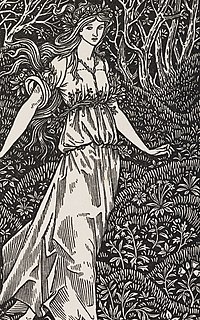
The Wood Beyond the World is a fantasy novel by William Morris, perhaps the first modern fantasy writer to unite an imaginary world with the element of the supernatural, and thus the precursor of much of present-day fantasy literature. It was first published in hardcover by Morris's Kelmscott Press, in 1894. The book's importance in the history of fantasy literature was recognized by its republication by Ballantine Books as the third volume of the Ballantine Adult Fantasy series in July, 1969. The Ballantine edition includes an introduction by Lin Carter.
A Dog's Purpose is a 2010 novel written by American W. Bruce Cameron, author of 8 Simple Rules for Dating my Teenage Daughter and How to Remodel a Man. The book chronicles a dog's journey through four lives via reincarnation and how he looks for his purpose through each of his lives.

Mr. Shivers is a 2010 novel by Robert Jackson Bennett and marks his literary debut. It was first published in hardback in the United States by Orbit Books on January 15, 2010. A paperback and audiobook release was also published during the same year; the audiobook is narrated by T. Ryder Smith. Set during the Great Depression, the book follows one man's attempt to take his revenge against the one who murdered his daughter. It has been described by the Los Angeles Review of Books as featuring "a band of Depression-era hobo vigilantes who trek across the Dust Bowl after the supernatural boogeyman, a metaphorical specter who haunts the starved nation".
Captain in Calico is a 2015 novel by George MacDonald Fraser. It was published seven years after his death in 2008 and is about the pirate Jack Rackham. Mary Read and Anne Bonny also appear as characters.



















